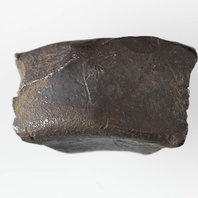
Viking Objects
Arm Ring Hacksilver (CM_1826_2001)
This piece of hacksilver was cut from a square section of a Scandinavian arm ring probably to pay for goods. The Vikings arriving in England had a bullion economy where they paid for goods with silver that was weighed to an amount agreed between the buyer and the seller. Hacksilver and silver ingots are the most common evidence for their bullion economy. It took some time for the Scandinavian settlers to adopt a monetary economy like that of the Anglo-Saxons, and both systems were used simultaneously for a while before they fully adopted the new system. They were familiar with monetary economies but they treated coins as just another form of silver before adoption of a monetary economy.
Read More
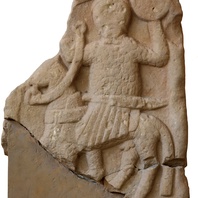
Viking Objects
Repton Stone (1989-59/1165)
The Repton Stone, as it is now known, was found in a pit near the eastern window of the Church of St Wystan, Repton, Derbyshire in 1979. It was originally carved on all four faces, but recognisable detail remains only on two of them. The Repton Stone is a section of a sandstone cross shaft carved on one side with a mounted armed figure (Face A), on the other with a monstrous creature eating the heads of two people (Face B). It was broken Face A: A moustachioed armed figure on horseback with sword and shield raised in the air is carved on this face. The horse is very clearly a stallion. Incised decoration, where the design is scratched into the surface, shows that the rider was depicted wearing armour and carrying a second weapon at his waist, perhaps a seax (knife or dagger). The armour was probably intended to be mail although the carving suggests scale. The mounted man appears to be wearing a diadem, suggesting that he was of high rank. He is wearing a pleated tunic under his armour, and has cross-gartered legs. The reins of the horse are looped over his right arm. Elements of the tack are clearly visible. Face B: This face would have been on the side of the cross. The monstrous creature on this face consists of a snake-like body with the face of a human being. The serpent beast appears to be devouring the heads of the two human figures that embrace in front of it. The serpent may be a representation of the Hellmouth devouring souls. The pit the stone was found in probably dates to the eleventh century or early twelfth century. However, the cross was probably much earlier in date, being broken up close to the time it was deposited in the pit. It is probable that the cross was made before the Viking camp in 873/4 because the monastery that stood on this site before the Vikings was not refounded after the Vikings adopted Christianity. The presence of this cross at the site of a Viking camp shows that Repton was an important place before the Vikings made it their temporary abode. This may have been one reason that the Vikings chose Repton for one of their camps, although its proximity to the River Trent would also have been an important factor. The Vikings used waterways to access the interior of the country, so it is not surprising to find their winter camps beside navigable rivers.
Read More
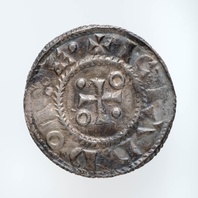
Viking Objects
Sihtric Caoch Silver Penny (CM.34-2000)
A sword and cross type silver penny of Sihtric Caoch (Sihtric Cáech) minted for the Viking kingdom of Northumbria. Sihtric Caoch was the Scandinavian ruler of Dublin from 917-920 CE and subsequently the ruler of Northumbria from 921-927 CE. It is not certain why he left Ireland. The Irish annals state that it was ‘through the grace of God’ and do not elaborate on the politics behind his departure. After the establishment of the Danelaw, some Viking leaders decided to mint their own coins to solidify their legitimacy in the eyes of the local populace. This created a hybrid economy where some members of the Danelaw used bullion and others used coins. This coin was part of a hoard of twelve coins found at Thurcaston between 1992 and 2000. The coins are Anglo-Saxon, Arabic and Viking issues, and show the diverse and wide-ranging contacts between societies at this time. The hoard was probably deposited c.923-925 CE, approximately five years after Leicester had been retaken by Mercia (c.918 CE). They indicate that a bullion economy was still operating in the Danelaw as late as the 920s. This suggests that the reconquest did not manage to institute Anglo-Saxon practices such as a monetary economy immediately.
Read More
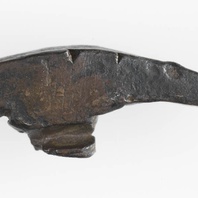
Viking Objects
Silver Thor’s Hammer Pendant (CM_1841_2008)
This is a high quality hammer-head section of a silver Thor’s hammer pendant. These may have been worn to show devotion to the god Thor, or to secure the god’s protection, although there is little evidence to support this interpretation. Pendants like this have been found made of lead, copper alloy, silver and gold, showing that many different strata of society could have worn them. For more information on Scandinavian jewellery in England check out our blog: Brooches, Pendants and Pins: Scandinavian Dress Accessories in England.
Read More
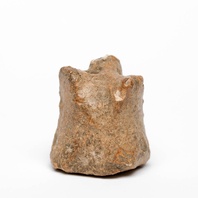
Viking Objects
Lead Gaming Piece (CM.574-2010)
This solid sub-circular based lead gaming piece has three projections on the top. This and similar pieces have also been interpreted as weights although the gaming piece interpretation is more secure. Pieces like this would have been used to play hnefatafl and/or Nine Men’s Morris, both of which are known to have been played in Scandinavia in the Viking Age.
Read More
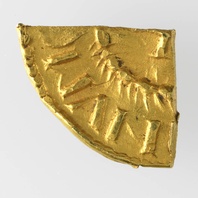
Viking Objects
Imitation Carolingian Gold Solidus (CM.521-1998)
This cut-quarter of an imitation gold solidus is one of 80 known imitations as opposed to 15 official solidi and is a copy of coins issued by Louis the Pious (778-840 CE). It was probably made somewhere in Frisia on the north-west coast of what is now the Netherlands. The importance of this carefully divided quarter-coin is as evidence for the acceptance of solidi on its actual monetary value rather than as mere bullion in the 9th century; if it were hack-gold it would not have been cut so meticulously. The Vikings would have obtained real and imitation Carolingian coins through their raiding and trading activities in the Frankish Empire.
Read More
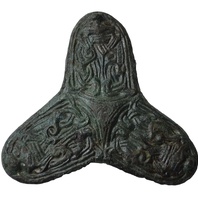
Viking Objects
Trefoil brooch (LCNCC : 2011.99)
A trefoil brooch with Borre/Jellinge-style cast ornament belonging to Peterson’s type 109. The brooch is most probably cast of copper alloy with traces of gilding on its upper surface and white metal plating on the reverse. While of Scandinavian design, many examples found in the East Midlands were probably made in the Danelaw, and may have been copies of Scandinavian styles, instead of being imported from Scandinavia. For more information on Scandinavian jewellery in England check out our blog: Brooches, Pendants and Pins: Scandinavian Dress Accessories in England.
Read More
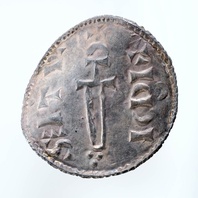
Viking Objects
Sihtric Caoch Silver Penny (CM.863-2002)
A sword and cross type silver penny of Sihtric Caoch (Sihtric Cáech) minted for the Viking kingdom of Northumbria. Sihtric Caoch was the Scandinavian ruler of Dublin from 917-920 CE and subsequently the ruler of Northumbria from 921-927 CE. It is not certain why he left Ireland. The Irish annals state that it was ‘through the grace of God’ and do not elaborate on the politics behind his departure. After the establishment of the Danelaw, some Viking leaders decided to mint their own coins to solidify their legitimacy in the eyes of the local populace. This created a hybrid economy where some members of the Danelaw used bullion and others used coins. This coin was part of a hoard of twelve coins found at Thurcaston between 1992 and 2000. The coins are Anglo-Saxon, Arabic and Viking issues, and show the diverse and wide-ranging contacts between societies at this time. The hoard was probably deposited c.923-925 CE, approximately five years after Leicester had been retaken by Mercia (c.918 CE). They indicate that a bullion economy was still operating in the Danelaw as late as the 920s. This suggests that the reconquest did not manage to institute Anglo-Saxon practices such as a monetary economy immediately.
Read More
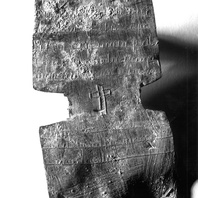
Viking Objects
Inscribed Lead Plaque (LCNCC:1996.64.045)
This lead plaque of uncertain function has a cross incised in its centre and a long Latin text in the Roman alphabet. Like the Saltfleetby spindle whorl, this inscription, too, calls on a divine power, in this case Christ. Between them the two inscriptions represent different responses to literacy and religion in the same time period in neighbouring but probably different communities. (Cumberworth is about 15 miles south of Saltfleetby, in an area with many Scandinavian place-names.) This fragmentary inscription begins with a cross and XPI, the sign for Christ, and after a gap in the text ends with ‘he who by the power of the cross redeemed the world from death, shattered hell or threw open heaven’. The object is dated to the late 10th or 11th century on the basis of the similarity of the writing to contemporary manuscripts.
